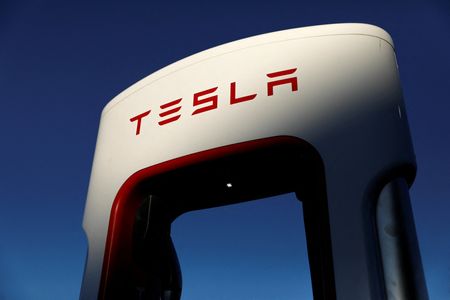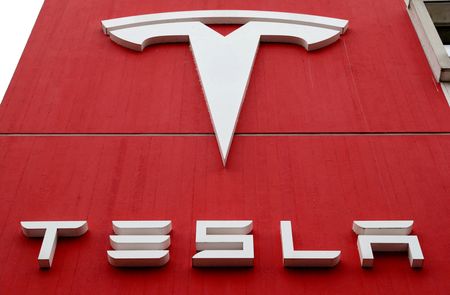By Akash Sriram and Hyunjoo Jin
(Reuters) -Tesla CEO Elon Musk signalled on Wednesday that he would cut prices again on electric vehicles in “turbulent times”, even as his all-out price war on automaker rivals squeezes the company’s own margins.
The company has slashed prices several times in the United States, China and other markets since late last year, and increased discounts and other incentives to reduce inventory, as it tries to shield against competition and economic uncertainty.
“One day it seems like the world economy is falling apart, next day it’s fine. I don’t know what the hell is going on,” Musk told analysts on a conference call. “We’re in, I would call it, turbulent times.”
Tesla shares, which had been largely flat after hours, fell nearly 5% after Musk’s comments.
The large price cuts have pressured Tesla’s automotive gross margin, a closely watched indicator in the industry, but Musk has said Tesla would sacrifice margin to drive volume growth.
He said so again on Wednesday: “I think it makes it does make sense to sacrifice margins in favor of making more vehicles,” adding that if macroeconomic conditions were not stable, Tesla would have to lower prices.
As an example, Tesla this year cut U.S. prices of its Model Y long-range version by a quarter to $50,490.
Tesla’s quarterly automotive gross margin, excluding regulatory credits, fell to 18.1% in the second quarter from 19% in the first quarter, according to Reuters’ calculations. That was in line with Street estimates, but a far cry from the 26% it reported a year earlier.
Tesla reported overall gross margin of 18.2% for the April-June period, the lowest in 16 quarters.
Earlier, Tesla said in a statement it was focusing on reducing costs and on new product development, and that the “challenges of these uncertain times are not over.”
“Multiple rounds of aggressive price cuts has put Tesla in a position of strength after building its EV castle and now is set to further monetize its success,” Wedbush analysts said in a note.
Tesla reiterated its expectations of achieving deliveries of around 1.8 million vehicles this year, but said production in the third quarter would decrease slightly due to planned downtimes for factory upgrades.
“It’s a fine line,” said Thomas Martin, a portfolio manager at Globalt Investments, which holds Tesla stock.
“They are trying to get the prices right so they can generate the demand for the units, and then they like to run their factories as efficiently as they can … they don’t want to build up those inventories.”
Lower pricing, along with government tax breaks for EV buyers in the United States and elsewhere, drove Tesla’s deliveries to a record 466,000 vehicles in the April-July period globally, but ate into its profitability.
Still, on an adjusted basis, Tesla earned 91 cents per share, on the strength of non-core income and largely in line revenue $24.93 billion. Analysts had expected a profit of 82 cents per share, according to Refinitiv.
FSD LICENSE
Musk said on the call that Tesla was in talks with a major original equipment manufacturer to license its “full self driving” (FSD) software but did not name the company. He had previously said the company was open to licensing the driver-assistance system.
FSD does not make the car autonomous and requires driver supervision, and Tesla is under regulatory security following a number of crashes involving its vehicles.
Last year, Musk said the world’s most valuable car maker would be “worth basically zero” without achieving full self-driving capability.
Tesla’s stock received a big boost this year after Ford Motor, General Motors and a raft of other automakers and EV charging firms said they would adopt Tesla’s charging technology.
The company’s stock has risen 60% since the first such deal on May 25. So far this year it is up 138%, helped also by expanded federal credits for Model 3s and investor excitement over artificial intelligence.
The company said on Wednesday that lower raw-material costs and government tax credits helped reduce cost-per-vehicle but that it saw an increase in operating expenses driven by Cybertruck, AI projects, and the production ramp of 4680 battery cells that are key to making cheaper and compelling EVs.
Tesla benefited from $150 million to $250 million in tax credits in the second quarter, it said, while receiving similar benefits from lower raw material costs such as lithium and aluminum.
Tesla said on Wednesday it had made “notable progress” on yield improvement of its 4680 cell production lines and increased production in Texas by 80% in the second quarter from the first.
In 2020, Musk unveiled a plan to produce Tesla’s own EV batteries called “4680” cells. But the carmaker has struggled to meet Musk’s targets for production and performance of the cells.
Tesla said production of the long-delayed electric pickup Cybertruck remained on track for initial deliveries this year.
(Reporting by Akash Sriram in Bengaluru and Hyunjoo Jin in San Francsico; Additional reporting by Abhirup Roy, Peter Henderson and Joe WhiteWriting by Sayantani GhoshEditing by Peter Henderson, Matthew Lewis and Sam Holmes)


